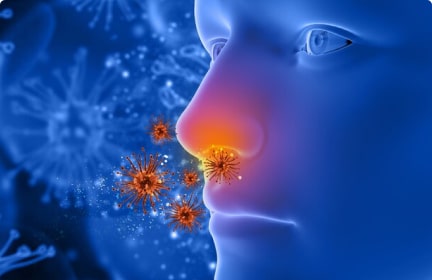What is influenza?
Influenza, caused by an infection with an influenza virus, is an acute respiratory illness affecting the upper and/or lower parts of the respiratory tract. It is characterised by sudden onset of high fever, myalgia, headache, severe malaise, non-productive cough, sore throat and rhinitis.
What are the types of influenza viruses?
The currently circulating influenza viruses that cause human disease are divided into two groups: Type A and B. Influenza viruses are defined by two different antigens – the haemagglutinin and neuraminidase components – on the surface of the virus.
How serious is influenza?
The most common complications of influenza are bronchitis and secondary bacterial pneumonia. Influenza poses a serious risk in the very young, the elderly and people suffering from medical conditions such as pulmonary disease, diabetes, cancer or cardiovascular problems. In these people, infection may lead to severe complications of underlying diseases, pneumonia and death
How is influenza spread?
The influenza virus is transmitted through the air by droplets and small particles generated when infected individuals cough or sneeze. The virus subsequently infects cells in the lining of the nose or throat and viral replication occurs within 4–6 hours. Disease spreads very quickly especially in crowded circumstances.
How is influenza diagnosed?
The diagnosis of influenza is usually based on clinical symptoms, although it may be difficult to differentiate the symptoms from other acute respiratory infections. Laboratory tests allow the detection of the influenza virus or viral protein in throat and/or nose swabs and antibodies in blood.
Are there other viruses that can cause similar illnesses?
Infections with a rhinovirus, respiratory syncytial virus (RSV), adenovirus and parainfluenza viruses may cause an influenza-like illness.
What is avian influenza?
Avian influenza, or bird flu, is caused by avian influenza viruses, which occur naturally among birds. These viruses can be low or highly pathogenic. Low pathogenic viruses cause asymptomatic infections in birds, while highly pathogenic viruses are associated with severe disease and high mortality. H5N1 is a highly pathogenic strain of avian influenza virus which is of current human pandemic concern. It has been the cause of the majority of recent outbreaks among domestic poultry in Asia, and can jump the species barrier, causing severe disease in humans and other mammals.
What is an epidemic?
An influenza epidemic is defined as the occurrence in a community or region of cases of influenza clearly in excess of normal year-round frequency. Influenza viruses exhibit seasonality causing epidemics in the winter months (October to March in the northern hemisphere and April to September in the southern hemisphere), while in tropical regions, viruses are present year round with periods of increased activity.
What is a pandemic?
A pandemic is the spread of an infectious disease in populations over a large geographical area. With influenza, the term pandemic is restricted to the worldwide spread of a new influenza virus subtype. As the population has little or no immunity to the new virus, rapid spread, causing high levels of illness and death, especially in young, healthy people occurs.
When is the next pandemic likely to occur?
Pandemics are unpredictable. In the 20th century, severe pandemics occurred in 1918 (‘Spanish Flu’), 1957 (‘Asian Flu’) and 1968 (‘Hong Kong Flu’). Most recently, in 2009 the world experienced the H1N1 pandemic (“swine flu”). Experts believe that an avian influenza pandemic could be a very real possibility, with the current global treats being from the H5N1 and H7N9 viruses.
How can influenza be prevented?
Vaccination is the principal measure for preventing influenza and reducing the impact of epidemics. Constant genetic changes in influenza viruses mean that the vaccine composition must be regularly updated to include the most recent circulating influenza A(H3N2), A(H1N1) and influenza B viruses. The effectiveness of influenza vaccine depends primarily on the age and immunocompetence of the vaccine recipient and the degree of similarity between the viruses in the vaccine and those in circulation.
How is the composition of influenza virus vaccine established?
The Global Influenza Surveillance and Response System (GISRS) of the World Health Organization (WHO) makes biannual recommendations on the vaccine composition. The network – a partnership of 112 National Influenza Centres in 83 countries – is responsible for monitoring the influenza viruses circulating in humans and rapidly identifying new strains. Based on information collected by the Network, WHO makes recommendations biannually on vaccine composition for both trivalent and quadrivalent seasonal influenza vaccines. This ensures that the vaccines contain the influenza A(H1N1), A(H3N2) and B strains most likely to be in circulation.
How is influenza treated?
Antiviral drugs for influenza are effective for the treatment and prevention of influenza. They are an important adjunct to influenza vaccination. The neuraminidase inhibitors are the currently recommended antivirals effective against both influenza A and B viruses. They must be taken early after infection (within 48 hours) to be effective in reducing symptoms and the more severe outcomes of influenza.
Antibiotics have no role in treating influenza in otherwise healthy people although they are used to treat complications. In severe influenza, admission to hospital, intensive care, antibiotic therapy to prevent secondary infection and breathing support may be required.

